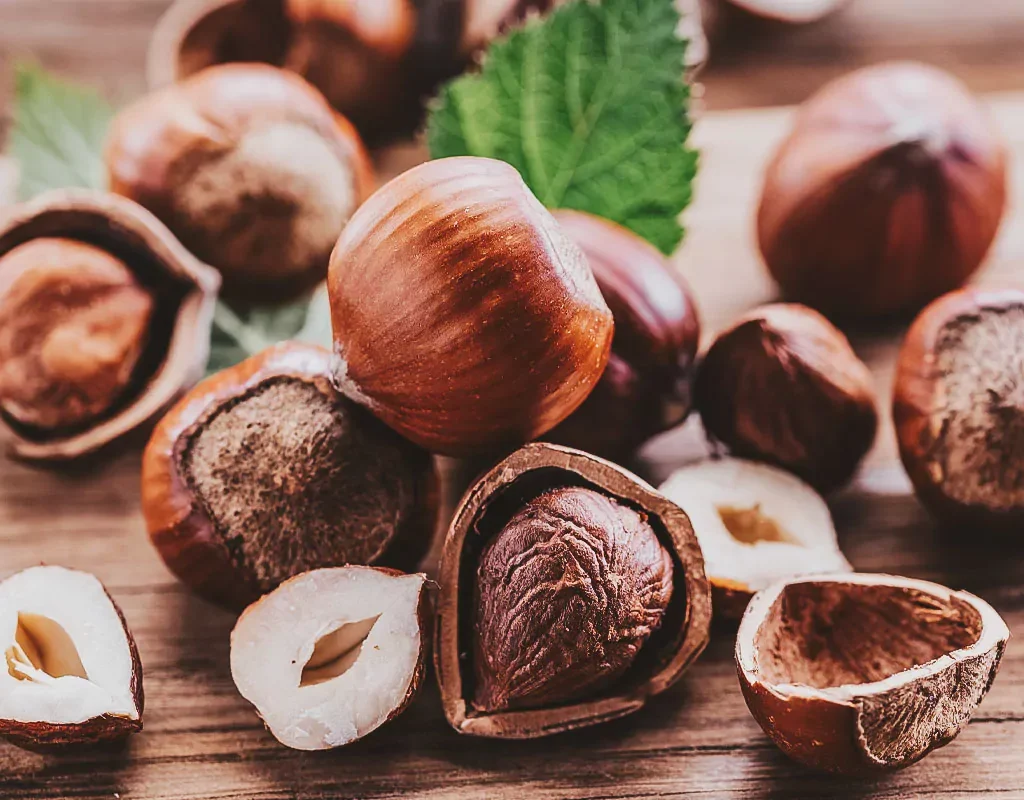When you think of decadent chocolates, creamy spreads like Nutella, or gourmet pastries, one nut often plays a starring role: the hazelnut. Loved for its rich, earthy flavor and satisfying crunch, hazelnuts are not only a kitchen favorite but also a valuable agricultural commodity. But have you ever wondered which country leads the world in hazelnut production? Let’s explore the global hazelnut market and uncover where this beloved nut grows in abundance.
What Are Hazelnuts?

Hazelnuts, scientifically known as Corylus avellana, are the edible seeds of hazel trees, native to Europe and Western Asia. They have been consumed for thousands of years and are renowned for their rich, slightly sweet flavor and versatile use in both sweet and savory dishes.
In addition to their culinary appeal, hazelnuts are a nutritional powerhouse, packed with heart-healthy fats, antioxidants, vitamins, and minerals like vitamin E, magnesium, and copper. They’re commonly used in baked goods, confections, nut butters, and as an ingredient in premium chocolate products.
Turkey: The World’s Hazelnut Powerhouse
When it comes to hazelnut production, Turkey is the undisputed global leader. This Mediterranean nation dominates the market, consistently producing around 65% to 75% of the world’s total hazelnut supply.
Production Statistics
According to the International Nut and Dried Fruit Council (INC) and the Food and Agriculture Organization (FAO), Turkey produces over 600,000 to 800,000 metric tons of hazelnuts in-shell per year, depending on growing conditions and market demand.
The country not only leads in production but also in exports, shipping hazelnuts to over 100 countries worldwide. Turkey’s hazelnuts are prized for their quality and flavor, with many international chocolate manufacturers — including Ferrero, the maker of Nutella and Ferrero Rocher — sourcing a significant portion of their hazelnuts from Turkish farms.
Where Hazelnuts Grow in Turkey

The majority of Turkey’s hazelnut orchards are located along the Black Sea region, where the climate is perfect for hazelnut cultivation — mild, humid summers and rainy winters.
The most productive provinces include:
- Ordu (the largest hazelnut-producing province)
- Giresun (known for its premium-quality hazelnuts)
- Samsun
- Trabzon
- Rize
In these regions, thousands of smallholder farmers cultivate hazelnuts on terraced hillsides overlooking the Black Sea. Harvest typically takes place between late July and September, with nuts collected by hand or mechanical harvesters.
Why Is Turkey the Leading Producer?
Several factors contribute to Turkey’s dominance in hazelnut production:
- Ideal Climate: The Black Sea’s temperate, humid climate provides the perfect growing conditions for hazelnuts.
- Long-Standing Tradition: Hazelnut cultivation has been a way of life in Turkey for centuries, with generational knowledge passed down through families.
- High-Quality Varieties: Turkey grows several prized varieties, notably the Tombul hazelnut, renowned for its rich flavor and high oil content.
- Global Demand: Turkey’s position as a trusted supplier to major chocolate and confectionery companies ensures steady export opportunities.
Italy: Europe’s Hazelnut Gem

After Turkey, Italy ranks as the second-largest hazelnut producer in the world, contributing approximately 8% to 12% of the global supply. Italian hazelnuts are highly prized for their exceptional quality and are frequently used in gourmet chocolates, pastries, and liqueurs.
Key Growing Regions
Italy’s hazelnut orchards are primarily concentrated in:
- Piedmont (home to the celebrated Tonda Gentile variety)
- Campania
- Lazio
- Sicily
The Tonda Gentile delle Langhe hazelnut from Piedmont is often considered the finest hazelnut variety globally, renowned for its sweetness, round shape, and consistent size — qualities highly valued by premium chocolatiers.
Other Major Hazelnut Producers
While Turkey and Italy lead the market, several other countries also cultivate hazelnuts on a significant scale:
Azerbaijan
A fast-growing hazelnut producer, Azerbaijan has invested heavily in expanding its orchards in recent years. The country produces about 50,000 to 60,000 metric tons annually, with much of its harvest exported to Europe and Russia.
Georgia
Neighboring Turkey and Azerbaijan, Georgia has ideal conditions for hazelnut production. The country produces around 30,000 to 40,000 metric tons per year, with hazelnuts becoming one of its most valuable agricultural exports.
United States
The U.S. — particularly the Willamette Valley in Oregon — produces about 35,000 to 50,000 metric tons annually. While small in comparison to Turkey, American-grown hazelnuts are known for their large size and excellent flavor.
Spain, France, and Chile
These nations also contribute smaller but valuable amounts of hazelnuts to the global market, often focusing on premium and organic varieties for gourmet use.
Global Hazelnut Consumption and Market Trends

Hazelnuts are enjoying increased global demand due to their versatility, nutritional benefits, and use in premium food products. The largest consumers include:
- Chocolate manufacturers: Ferrero, Lindt, and Godiva are among the biggest buyers.
- Bakery and confectionery producers
- Health-conscious consumers: seeking plant-based, protein-rich, and heart-healthy snacks.
Growth in Asia and the Middle East
Emerging markets like China, India, and the Middle East are showing growing interest in hazelnut products, fueling demand for both raw and processed hazelnuts.
Health Benefits of Hazelnuts
Part of the global demand surge is fueled by rising health awareness. Hazelnuts offer several health benefits:
- Rich in monounsaturated fats: promoting heart health.
- High in antioxidants: protecting against cell damage.
- Excellent source of Vitamin E: supporting skin and immune health.
- Contains fiber, magnesium, and B vitamins: contributing to overall wellness.
Studies suggest that regular consumption of nuts like hazelnuts can help lower cholesterol, reduce inflammation, and improve heart health.
Challenges in Hazelnut Production

Despite its dominance, the global hazelnut industry faces challenges:
- Climate change: Alters flowering and harvest cycles, affecting yields.
- Labor shortages: Particularly in Turkey, where much of the harvest is manual.
- Market dependency: Heavy reliance on a few large buyers makes producers vulnerable to price fluctuations.
Efforts are ongoing to improve sustainability, labor practices, and disease-resistant hazelnut varieties to protect future harvests.
The Future of Hazelnut Production
As consumer demand for plant-based, heart-healthy foods rises, the hazelnut industry is poised for growth. Global production is expected to increase, with new orchards being planted in countries like Chile, Iran, and Australia.
Technological advances in orchard management, harvesting, and processing are also improving efficiency and nut quality, ensuring hazelnuts remain a valuable commodity in international agriculture.
Final Thoughts
So, which country is the largest hazelnut producer in the world? Without a doubt, Turkey holds the crown, producing more than two-thirds of the global supply and setting the standard for quality and flavor. Italy, Azerbaijan, Georgia, and the United States also play important roles in the global market, while emerging producers prepare to meet growing international demand.
Whether enjoyed in chocolates, pastries, or as a healthy snack, hazelnuts continue to win hearts worldwide — and Turkey’s Black Sea orchards remain at the center of this beloved nut’s journey from farm to table.





